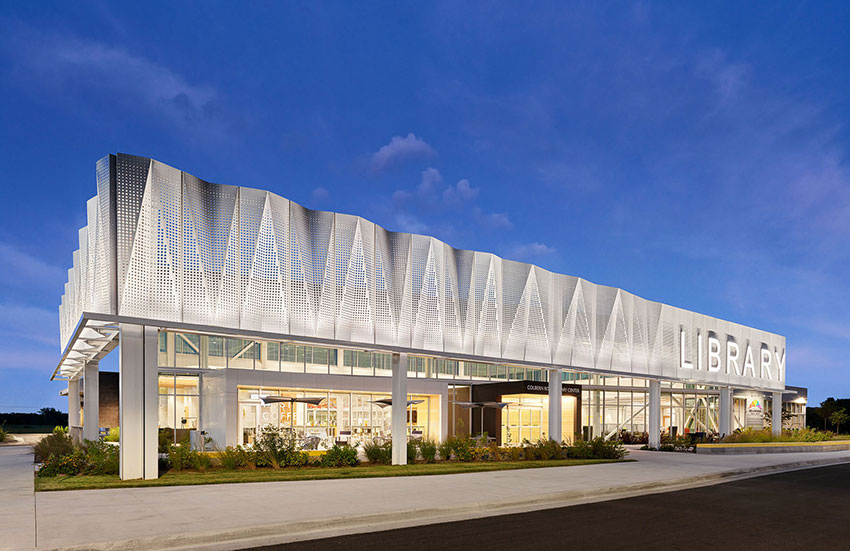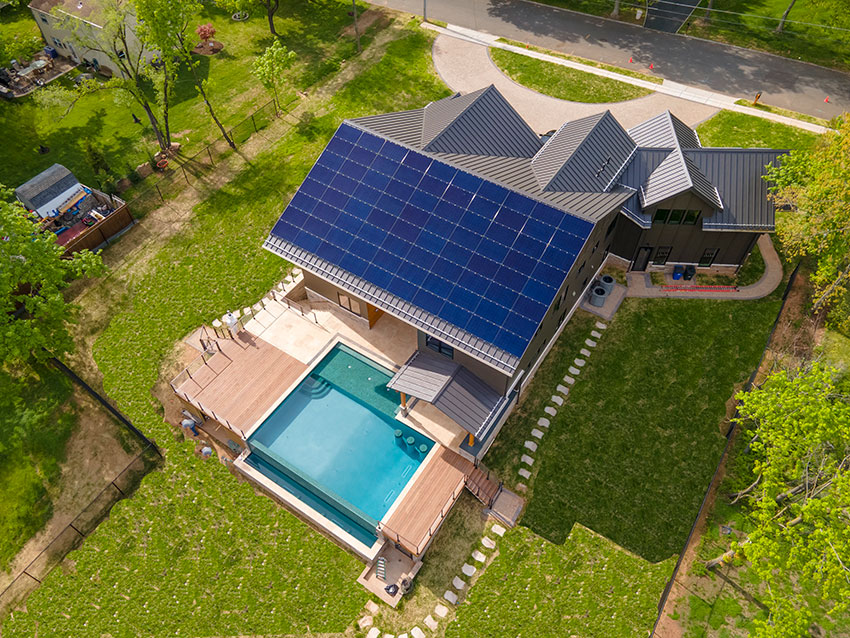This CE Center article is no longer eligible for receiving credits.
This section focuses on the durability of metal. It provides an overview of the benefits of using metal as a building material in commercial construction and explores why metal is often specified for walls and roofs over other materials, especially as architects and developers aim to construct more resilient, sustainable buildings.
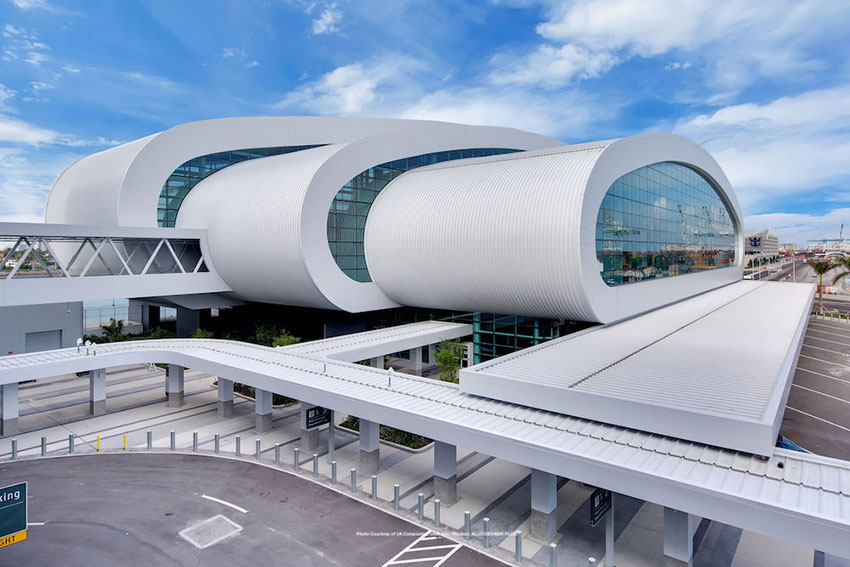
Photo courtesy of 3A Composites USA, Inc.
Norwegian Cruise Lines Terminal, Miami, Florida.
A BRIEF HISTORY OF METAL IN COMMERCIAL CONSTRUCTION
Metal buildings have a long history in commercial construction, with their earliest use in late 1700s England to build mills, factories, and agricultural buildings during the Industrial Revolution. Metal was less expensive—and less flammable—than brick and timber, and the advantages were quickly apparent. Commercial construction in the early 19th century United States slowly began to incorporate the newly mass-produced steel into buildings, with the wealthy in New York City as an early adopter due to the cost.
While this set the groundwork for later building projects, World War II is recognized as the tipping point for metal in commercial construction. Metal had beneficial attributes. It could be quickly prefabricated and shipped to construct structures such as airplane hangars, barracks, and other temporary shelters to support the war effort. Advantages of metal later were applied in agriculture and other industries that required strong, durable, and relatively easy-to-assemble structures. During the post-war era, metal building systems (MBS) became more common for basic large-scale storage or warehouse structures.
Steel grew increasingly popular, and the advancement of Computer Aided Design (CAD) in the mid-1970s allowed metal building design to be widely applied to commercial buildings. The rest is history. Today metal is specified as a building material in many commercial sectors, and for good reason. Metals such as steel are versatile and sustainable and last a long time with limited or no maintenance. Steel can be customized to meet specific design requirements, or it can be combined with other building materials to suit a design.

Photo courtesy of Nucor Corporation
Boeing 787 Dreamliner final assembly plant, North Charleston, South Carolina.
Benefits of Metal Construction Compared to Other Materials
Compared to other materials such as wood, concrete, or brick, metal proves versatile and cost-effective over its lifetime, as well as lightweight, sustainable, and durable. Many materials will fall to rot or decay with water exposure, but properly designed, constructed, and maintained metal can last for years.
With newer composite materials that incorporate insulation and protective finishes, architects and builders can choose from products that offer increased performance and design options. These attributes lead with durability, placing metal high on the list of ideal building materials for commercial construction projects.
In the construction world, durability typically refers to a material’s ability to withstand the elements, resist damage, and handle structural pressure. Buildings constructed with metal building products such as wall panels and roofing can last decades with minimal maintenance or repair, even when exposed to extreme weather or natural disasters.
Benefits of Metal Walls in Commercial Construction
Metal walls are increasingly common in both residential and commercial construction thanks to increased versatility and sustainability as well as advances in panel design. Commercial construction projects benefit from the advantages of metal walls. This holds true for both new construction and retrofits. Metal walls can provide protection against both fire and water, stand up to wear and tear, and offer lower material costs, as well as lower costs for installation and maintenance. On top of that, metal walls are versatile when it comes to design aesthetics, and they offer architects a huge range of options for both interior and exterior walls.
Designers and builders have several options when it comes to metal walls. Three of the most common metal wall panels are insulated metal panels (IMPs), metal composite material (MCM) panels, and single-skin panels.
Insulated Metal Panels (IMPs)
Insulated metal panels (IMPs) are exterior cladding elements constructed with composite materials. Their exceptional performance stems from the combined metal skins and rigid insulative core. The core can be made of different materials, including mineral wool, which may be fire rated. Along with a vapor-retarding thermal barrier, IMPs are designed to be highly insulative, lightweight and weather resistant; they can be used for roofs or walls and are an excellent choice for commercial construction.
Aside from weather resistance and thermal benefits, IMPs carry many other attributes that will be discussed later including aesthetics and increased energy efficiency. Features such as the design and installation of assembly systems, however, connect to durability.
Where IMPs have similar installation to concrete tilt-wall and precast options, they are quicker and easier to install when used as roof systems. A notable characteristic is they can be installed with a single pass and span large sections of a structure. From an aesthetic perspective, IMPs are highly versatile in size, width, color, profile, and finish. Not surprisingly, IMPs are frequently used for large buildings, from warehouses and manufacturing facilities to healthcare, educational, recreational, and government buildings.
A stand-out benefit of IMP walls hinges on insulative properties. With panels from 3-8 inches, walls can be designed to provide a climate-controlled interior environment. For example, manufacturing and processing facilities may require a controlled climate to keep food or other materials fresh. Storage facilities may require a consistent climate temperature to keep products stable and safe. In either case, lower operational CO2e emissions will improve performance, so a carefully considered building envelope material such as IMP lowers operational energy use.
IMPs used in commercial and institutional buildings offer a balance of energy efficiency, durability, and lower cost. While some of these features are similar in other commercial and industrial wall segments, IMPs offer the versatility of custom shapes, colors, finishes, and custom fabrication. Architectural IMPs can be customized to mesh with unique building designs while ensuring cohesion in the building envelope. IMPs are designed to integrate well with customized windows, louvers, or sunshade systems available through the manufacturer or their partners.
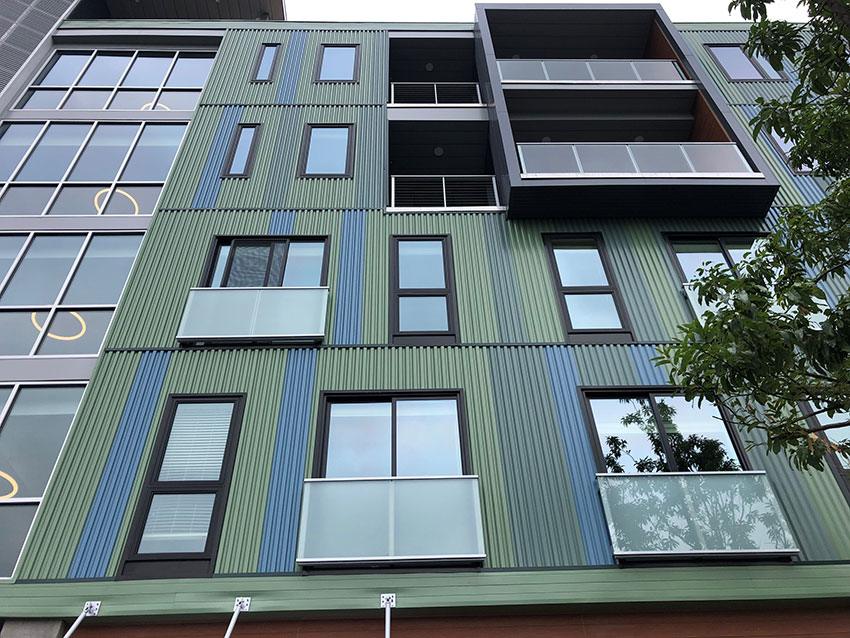
Photo courtesy of ATAS International Inc.
Lakeview Green Apartment Complex, Birmingham, Alabama.
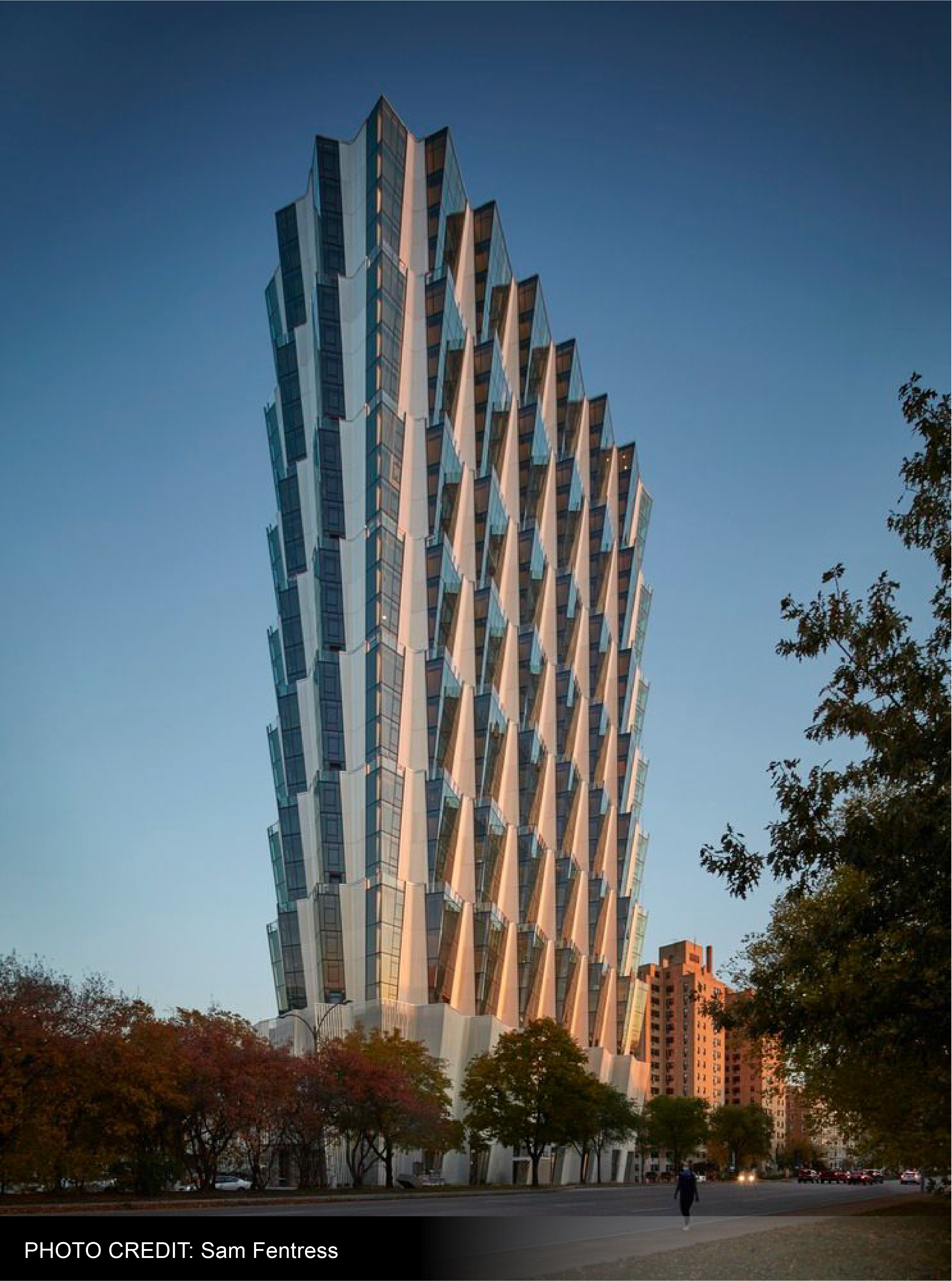
Photo: Sam Fentress
100 Above the Park, St. Louis, Missouri.
Metal Composite Material (MCM) Panels
Metal composite material (MCM) is the current iteration of aluminium composite material (ACM), which was introduced in 1969. Over the past 50 years, MCM has become increasingly popular as a commercial building material thanks to high-performance stainless steel and high-tech natural metal skins made from zinc, copper, and titanium, all of which provide a modern look to architectural designs.
As an exterior wall material, MCM panels are an affordable, durable, high-quality option for designers. One of the top selling points of MCM is that the metal sheets are engineered and fabricated to ensure they remain consistently flat during installation. Depending on the material, a design aesthetic can change. Aluminum MCM, for example, can be finished with different colors, and other metals such as zinc, copper, stainless steel, and titanium can be used as panel skins to highlight the aesthetic of the metal.
These finishes add to the durability of MCM panels. The material can look new for decades while protecting the structure.
This section focuses on the durability of metal. It provides an overview of the benefits of using metal as a building material in commercial construction and explores why metal is often specified for walls and roofs over other materials, especially as architects and developers aim to construct more resilient, sustainable buildings.

Photo courtesy of 3A Composites USA, Inc.
Norwegian Cruise Lines Terminal, Miami, Florida.
A BRIEF HISTORY OF METAL IN COMMERCIAL CONSTRUCTION
Metal buildings have a long history in commercial construction, with their earliest use in late 1700s England to build mills, factories, and agricultural buildings during the Industrial Revolution. Metal was less expensive—and less flammable—than brick and timber, and the advantages were quickly apparent. Commercial construction in the early 19th century United States slowly began to incorporate the newly mass-produced steel into buildings, with the wealthy in New York City as an early adopter due to the cost.
While this set the groundwork for later building projects, World War II is recognized as the tipping point for metal in commercial construction. Metal had beneficial attributes. It could be quickly prefabricated and shipped to construct structures such as airplane hangars, barracks, and other temporary shelters to support the war effort. Advantages of metal later were applied in agriculture and other industries that required strong, durable, and relatively easy-to-assemble structures. During the post-war era, metal building systems (MBS) became more common for basic large-scale storage or warehouse structures.
Steel grew increasingly popular, and the advancement of Computer Aided Design (CAD) in the mid-1970s allowed metal building design to be widely applied to commercial buildings. The rest is history. Today metal is specified as a building material in many commercial sectors, and for good reason. Metals such as steel are versatile and sustainable and last a long time with limited or no maintenance. Steel can be customized to meet specific design requirements, or it can be combined with other building materials to suit a design.

Photo courtesy of Nucor Corporation
Boeing 787 Dreamliner final assembly plant, North Charleston, South Carolina.
Benefits of Metal Construction Compared to Other Materials
Compared to other materials such as wood, concrete, or brick, metal proves versatile and cost-effective over its lifetime, as well as lightweight, sustainable, and durable. Many materials will fall to rot or decay with water exposure, but properly designed, constructed, and maintained metal can last for years.
With newer composite materials that incorporate insulation and protective finishes, architects and builders can choose from products that offer increased performance and design options. These attributes lead with durability, placing metal high on the list of ideal building materials for commercial construction projects.
In the construction world, durability typically refers to a material’s ability to withstand the elements, resist damage, and handle structural pressure. Buildings constructed with metal building products such as wall panels and roofing can last decades with minimal maintenance or repair, even when exposed to extreme weather or natural disasters.
Benefits of Metal Walls in Commercial Construction
Metal walls are increasingly common in both residential and commercial construction thanks to increased versatility and sustainability as well as advances in panel design. Commercial construction projects benefit from the advantages of metal walls. This holds true for both new construction and retrofits. Metal walls can provide protection against both fire and water, stand up to wear and tear, and offer lower material costs, as well as lower costs for installation and maintenance. On top of that, metal walls are versatile when it comes to design aesthetics, and they offer architects a huge range of options for both interior and exterior walls.
Designers and builders have several options when it comes to metal walls. Three of the most common metal wall panels are insulated metal panels (IMPs), metal composite material (MCM) panels, and single-skin panels.
Insulated Metal Panels (IMPs)
Insulated metal panels (IMPs) are exterior cladding elements constructed with composite materials. Their exceptional performance stems from the combined metal skins and rigid insulative core. The core can be made of different materials, including mineral wool, which may be fire rated. Along with a vapor-retarding thermal barrier, IMPs are designed to be highly insulative, lightweight and weather resistant; they can be used for roofs or walls and are an excellent choice for commercial construction.
Aside from weather resistance and thermal benefits, IMPs carry many other attributes that will be discussed later including aesthetics and increased energy efficiency. Features such as the design and installation of assembly systems, however, connect to durability.
Where IMPs have similar installation to concrete tilt-wall and precast options, they are quicker and easier to install when used as roof systems. A notable characteristic is they can be installed with a single pass and span large sections of a structure. From an aesthetic perspective, IMPs are highly versatile in size, width, color, profile, and finish. Not surprisingly, IMPs are frequently used for large buildings, from warehouses and manufacturing facilities to healthcare, educational, recreational, and government buildings.
A stand-out benefit of IMP walls hinges on insulative properties. With panels from 3-8 inches, walls can be designed to provide a climate-controlled interior environment. For example, manufacturing and processing facilities may require a controlled climate to keep food or other materials fresh. Storage facilities may require a consistent climate temperature to keep products stable and safe. In either case, lower operational CO2e emissions will improve performance, so a carefully considered building envelope material such as IMP lowers operational energy use.
IMPs used in commercial and institutional buildings offer a balance of energy efficiency, durability, and lower cost. While some of these features are similar in other commercial and industrial wall segments, IMPs offer the versatility of custom shapes, colors, finishes, and custom fabrication. Architectural IMPs can be customized to mesh with unique building designs while ensuring cohesion in the building envelope. IMPs are designed to integrate well with customized windows, louvers, or sunshade systems available through the manufacturer or their partners.

Photo courtesy of ATAS International Inc.
Lakeview Green Apartment Complex, Birmingham, Alabama.

Photo: Sam Fentress
100 Above the Park, St. Louis, Missouri.
Metal Composite Material (MCM) Panels
Metal composite material (MCM) is the current iteration of aluminium composite material (ACM), which was introduced in 1969. Over the past 50 years, MCM has become increasingly popular as a commercial building material thanks to high-performance stainless steel and high-tech natural metal skins made from zinc, copper, and titanium, all of which provide a modern look to architectural designs.
As an exterior wall material, MCM panels are an affordable, durable, high-quality option for designers. One of the top selling points of MCM is that the metal sheets are engineered and fabricated to ensure they remain consistently flat during installation. Depending on the material, a design aesthetic can change. Aluminum MCM, for example, can be finished with different colors, and other metals such as zinc, copper, stainless steel, and titanium can be used as panel skins to highlight the aesthetic of the metal.
These finishes add to the durability of MCM panels. The material can look new for decades while protecting the structure.
Single-Skin Panels
As with MCM panels, single-skin metal panels, also known as preformed or roll-formed, are made from different metals, such as steel, aluminum, copper, and zinc, with metallic-coated steel being the most common in commercial building construction. Single-skin panels were initially used for large industrial projects such as warehouses and manufacturing plants. With more recent advances in metal panel manufacturing and finishing, and with more profile designs, single-skin panels can be used on almost any type of building.
Single-skin panels have also become remarkably versatile in commercial construction. For years, panels were limited to vertical installations. Now the panels are designed for many different installation options, including horizontal, diagonal, geometrically patterned, and curved. Perforated panels are also available. Single-skin panels can be used for bold statements on building exteriors while maintaining durability.
As with IMP and MCM, single-skin panels are treated with protective finishes. These preformed panels also are relatively economical to install, especially when compared to other building materials such as the synthetic stucco of exterior insulation finishing systems (EIFS). Preformed panels allow quick installation, thus saving time and money.
Benefits of Metal Roofs
Many of the same characteristics that make metal a smart choice for walls also make it ideal for roofing. Between the overall durability of the material and finishes, metal roofs can last for decades and contribute to the overall sustainability of a building. In addition to broad durability, metal roofs can be coated with finishes that reflect sunlight and reduce heat absorption, which in turn lowers cooling demands in summer. Many metal roof panels can provide excellent insulation, contributing to lower energy costs. Metal roofs make long-lasting, beautiful, and sustainable rooftop systems that contribute to the energy efficiency of the building. The metal used for roofs typically contains at least 25% recycled content, and when that roof reaches the end of its life, it will be 100% recyclable. The high recycled content can contribute to LEED credits for the project.
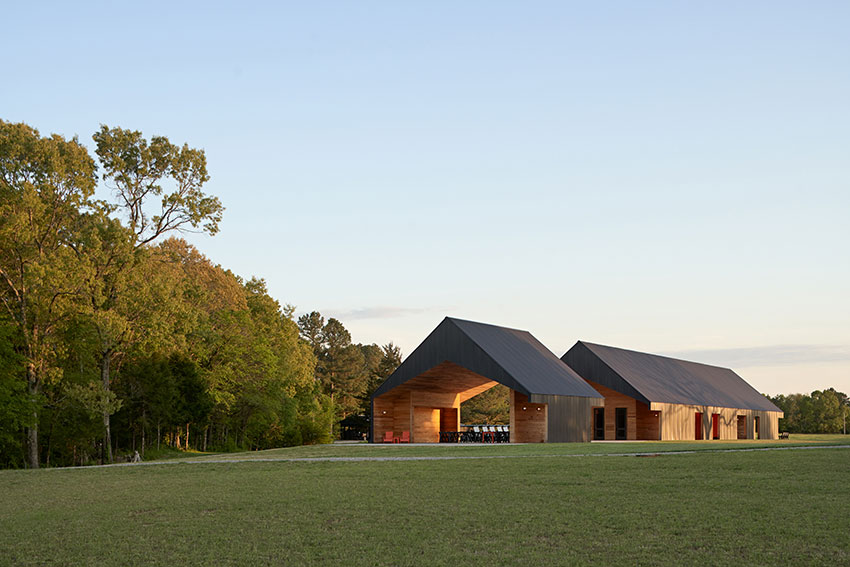
Photo: Mike Sinclair; courtesy of Sherwin Williams
Lone Oaks Farm Hunter Education Station, Middleton, Tennessee.

Photo courtesy of Drexel Metals
Pikes Peak Summit Complex, Colorado Springs, Colorado.
Low-Slope Metal Roofs
Low-slope metal roofs have a long history of being used to cover large building projects such as commercial or industrial structures. These roofing systems are exceptionally good at draining water away from the roof surface, thus extending the overall life of the roof and the building. As the name implies, low-slope metal panels are typically used on flatter rooftops that have pitches ranging from ¼:12 to 3:12. The roofing systems are made of interlocking panels with vertical and trapezoidal seams that run parallel to the roof slope, and are a good choice for larger-scale commercial projects in environments where the building will benefit from a long-lasting, lightweight roof. A lightweight roof is especially important in high seismic areas as it doesn’t add as much horizontal force as other heavier roofing materials.
Low-slope metal roofs can also include the traditional roofing method known as screw-down or through-fastened roofing. In these systems, the panels can easily be fastened directly over bar joists or purlins. This is a significant advantage over non-metal roofing systems, which can only be attached to an underlying substrate or roof deck. Not only does this save time and construction costs, but it also reduces the overall structural load. The fastening systems, which are interlocking or “active,” produce a highly resilient roof in high winds. From a standards perspective, uplift resistance of metal roof panel systems is determined by ASTM E1592, UL 580, UL 1897, and other uplift tests to ensure performance.
Moreover, large-scale projects that use low-slope roofs can benefit from the lengthy service life: these metal roofs can last 40 years or longer, depending on climate and manufacturer warranties.
Steep-Slope Metal Roofs
Steep-slope metal roofs have pitches of 3:12 or greater. They are available in many different metal types, with steel and aluminum as the most common, but copper and zinc panels are also options. Metal panels made from steel and aluminum are protected by high-performance, durable coatings that extend the longevity of the product. Copper and zinc naturally develop their own protective finish. All these roofing systems tend to be lightweight and wind resistant, and they are helpful for a building that requires a durable roof to shed water, snow, ice, and debris in order to avoid mold and mildew. The ability to release water and snow contributes to the overall durability, and manufacturers acknowledge that durability with warranties that range from 20 to 40 years, and in some cases more.
There are two categories of steep-slope metal roofs: structural and architectural. The main difference is how they are fastened to the underlying structure. Structural systems are available in several styles, such as vertical standing seam systems and corrugated or tile facsimile metal panel roofs. Vertical standing seam systems are attached to underlying purlins with hidden clips or fastening flanges. Corrugated systems, however, have fasteners attached through the metal panels, which either overlap or interlock on the side ends to ensure that the system is water-tight.
Structural systems can be attached directly to the building structure, but architectural steep slope metal roof systems can only be attached to an existing roof deck, such as plywood, oriented strand board, concrete, or metal. In addition to the vertical, corrugated, and tile options available with structural systems, architectural systems also include horizontal panel systems, shingles, and stamped metal tile.
Steep-slope metal roofs tend to be low maintenance in general. The reduced risk of water and debris build-up plays an important role in this, but so does the impact of protective coatings and finishes. These finishes are resistant to UV rays and protect the metal from acid rain, but they do more than just that. Through the application of heat-deflecting metal coatings, cooling loads may be reduced by as much as 40 percent or more, according to a study conducted by Oak Ridge National Laboratory. On top of functional benefits, steep slope metal roofs offer architects a wide range of colors and styles to enhance the design.
As with low-slope roofing systems, interlocking fastening systems are a key feature. Not only do they allow a relatively efficient installation, but the design also adds an additional level of protection against high winds.
Insulated Metal Roof Panel (IMP) Roof Systems
Insulated metal roof panels (IMPs) are at the top end of metal roofing products. They incorporate the best qualities of other metal roof options along with insulative properties born of a state-of-the-art design that bonds steel facings to the polyinsocyanurate insulating foam core. As a result, these roof systems provide exceptional and airtight thermal performance. IMPs can be used in almost any commercial or residential application regardless of the roof span, and they are equally applicable to low- and steep-slope roofs.
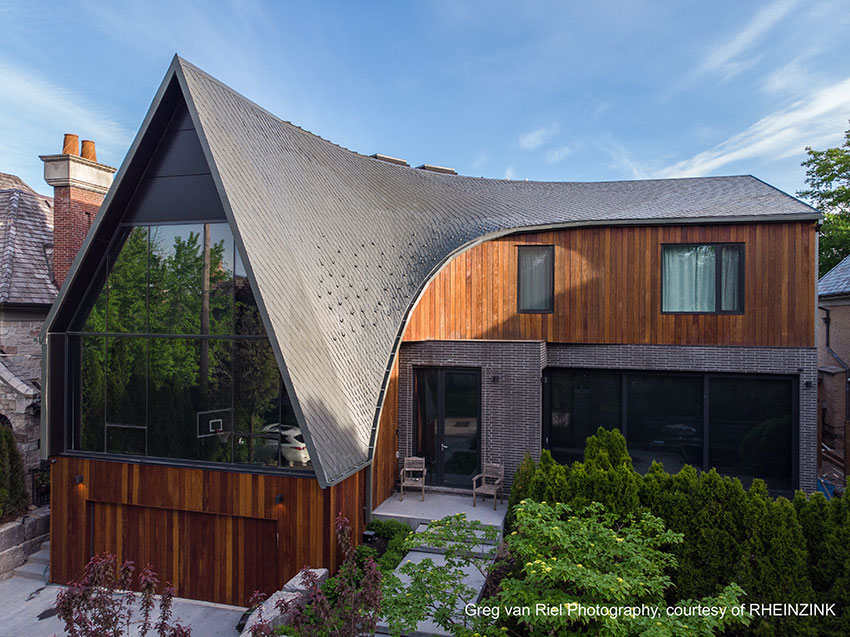
Photo courtesy of Rheinzink
Bézier Curve House, Toronto, Ontario.

Photo courtesy of Nucor Corporation
Insulated Metal Panel Roof. The Cannon, Houston, Texas.
The material properties of IMP roofing systems help create a durable, sustainable building envelope that will last decades. Panel designs are highly versatile, and include options such as trims and profiles, as well as accessories and different panel modules. As with other metal panels, they can be finished in natural and color coatings that protect the metal.
With insulation and high-tech coatings, IMPs are ideal for energy efficiency and building performance. Buildings in extremely hot environments can stay cooler when a high-performance roof is installed. This in turn lessens the strain on a building’s cooling system and reduces energy costs.
As a roofing option, IMPs contribute to both the overall building design and project timeline. IMPs tend to be custom-made and assembled in the factory, so they arrive on the jobsite ready for installation. Compared to older roofing systems that include multiple parts and have lengthy installation, IMPs can be quickly and efficiently installed on site.

Image courtesy of Nucor Corporation
IMP Joint Thermal Break.
THERMAL AND ENERGY-SAVING BENEFITS OF METAL CONSTRUCTION
It may seem counterintuitive that metal can have thermal and energy-saving benefits in commercial construction. After all, metal conducts both heat and cold very well, so thermal bridging is a concern. A hot metal roof or wall can easily increase the internal temperature of a building simply by transferring the exterior heat to the interior walls. Modern metal panels for walls and roofs, however, often include protective coatings that lessen the solar load, and most are designed with either insulative layers or an insulative backing that breaks the thermal bridge, solving the problem of thermal conduction. Metal is well-suited for ecofriendly building goals.
Benefits of Specifying Thermally Efficient Metal Panel Systems
When properly specified and installed, metal roofs and wall systems can help designers create structurally strong, lightweight, highly efficient buildings that have many thermal and energy-saving benefits. Whether as an insulation strategy, a solid foundation for roof-top renewable energy options, or simply as a superior roofing or wall product, metal directly equates with lower carbon emissions of commercial buildings through reduced energy use, lower maintenance, and fewer replaced materials. These energy-saving benefits are not just environmental solutions —they also improve the health, safety, and comfort of occupants.
A key goal for an energy-efficient, sustainable building is to minimize the energy needed for interior climate control. Materials and products designed to make buildings thermally stable throughout the year can help reduce heating and cooling costs, as well as lower operational CO2e emissions.
Many new metal roof and wall panels address the thermal bridging problem within the product design. MCMs and IMPs both have insulative materials sandwiched between metal skins, breaking any thermal conductivity along the surfaces. Single-skin panels, which don’t have insulation built into them, can also be installed on top of insulative layers, making them a more affordable panel option that still provides thermal protection to the building.
As with any exterior building material that must be securely attached to a structure, fasteners can risk thermal bridging. One of the many benefits of metal panel systems is that they are designed to incorporate large spans of coverage, and many include inlaid seams that help limit thermal bridging in metal attachment points. Modern metal roof and wall systems can, in turn, allow for excellent thermal performance of the overall building with minimal points for heat or cold to enter the structure.
On the higher performance end of the scale, IMPs offer exceptionally good thermal performance when used for both walls and roofs. The thermal performance stems from the thick insulation (usually ranging from 3-8 inches and from the airtight design of panels and fasteners, along with an excellent spanning capability. Together, these features provide superior levels of thermal (R-values) and airtightness performance over the service life of the building. Insulated roofs have a long service life, and are quick to install and easy to maintain, and that makes them ideal for low and high-rise commercial buildings. If a project requires a high-performance building enclosure, IMPs are perfect for the job.
Lower Maintenance and Less Frequent Replacement of Materials
There’s a reason many manufacturers place 20- to 40-year warranties on their metal walls and roofs—the products last a long time. And throughout the life of the wall or roof, maintenance tends to be minimal, thanks to protective coatings and finishes. From an energy-efficiency and sustainability standpoint, the durability and longevity both mean that once a roof or wall has been installed on a building, it’s likely that minimal additional energy will be needed to maintain the structure. When the structure does finally meet the end of its life cycle, metal can be recycled or repurposed rather than sent to a landfill. These recycled or repurposed metals contribute to the overall sustainable use of materials and reduce the demand for new resources that contribute to carbon emissions.
Metal walls and roofing also help reduce the carbon footprint of a project. When compared to other roofing materials such as asphalt shingles made of a crude oil by-product and not recyclable or biodegradable, metal roofs have a less carbon-intensive production process, and the material is recyclable. Both of these factors limit greenhouse gas emissions.
This proves useful not only for commercial construction projects but also for existing structures with poorly insulated roofs that were constructed prior to the newer, more energy-efficient building codes. Assuming the rest of a structure has the potential for a long life, replacing a less efficient roof with a newer metal roof with higher insulative properties can help extend its service life. A roof replacement can dramatically shift energy use and overall carbon emissions to lower the carbon footprint.
Health, Safety, and Well-Being of Building Occupants
So many attributes of thermal efficiency in metal panel walls and roofing can be directly applied to the way metal contributes to the overall health, safety, and well-being of building occupants.
Climate-controlled buildings, whether residential or commercial, help keep occupants comfortable and, by extension, safe. Large commercial buildings designed and constructed with properly insulated metal walls and metal roofs contribute to a healthy interior environment. These wall and roof systems can be easily integrated with HVAC systems, ensuring buildings are properly ventilated and keeping interior temperatures safe and comfortable.
Related benefits of metal walls and roofs include providing an exceptional barrier to fire and the natural elements, adding a level of safety not available in buildings constructed of other materials.
Metals used in construction are non-combustible with high melting points, so structures resist fire much longer than buildings consisting of less fire-resistant materials and contribute little fuel. Structures remain intact longer giving occupants more time to evacuate and firefighters more time to get in, helping minimize damage.
While steel, commonly used for walls and roofs, can withstand high heat loads, it is not immune to the impacts of fire. When steel reaches 593C, for example, it loses half its weight-bearing capability. This in turn can impact structural supports. Consequently, it is critical that buildings constructed with metal exteriors and interiors are fireproofed as a way to protect both the occupants and the structure itself. Fireproofing won’t prevent fires, but it can drastically reduce a fire’s impact.
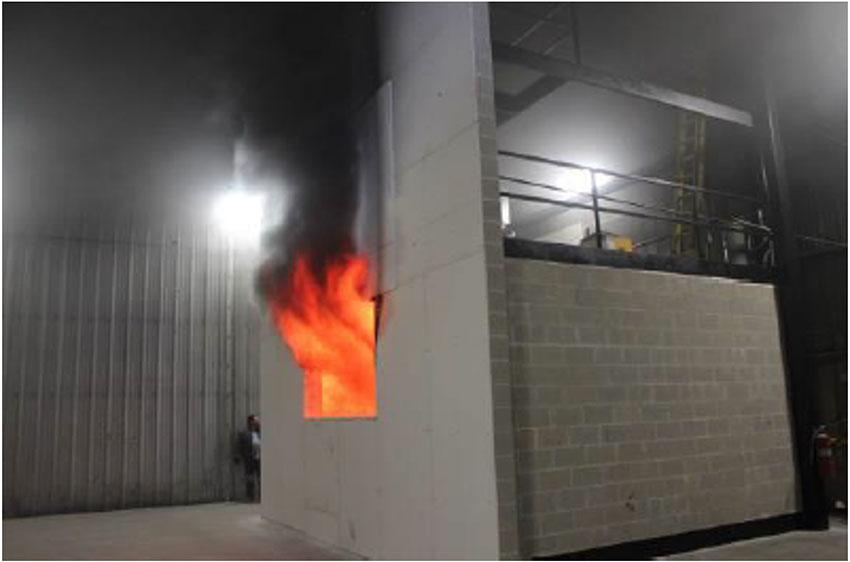
Photo courtesy of Intertek Building and Construction
NFPA-285 Fire Testing.
Structures that incorporate metal into a design, whether with rainscreen panels or metal roofing, are resilient against the elements. Rainscreens can be designed to withstand sun exposure through coatings and finishes, and they also prevent water intrusion. Buildings protected by metal panel walls or rainscreens stay dry and mold free, keeping occupants safe from mold exposure.
Metal roofs also help protect building occupants with durability and resilience. Standards require that metal roofing systems pass ASTM E1592, a test which applies high air pressure under an entire panel assembly. This test, one of the most rigorous in the industry, helps determine how a roofing system might perform in a hurricane or tornado. Natural disasters also carry the risk of roof decks detaching, or damage from wind, fire, or hail. Tests such as UL 1897 and UL 580 evaluate a roof deck’s attachment performance under negative and variable pressures, and FM 4471 includes ASTM E1592 and adds additional requirements for overall durability. Metal roofing systems perform extremely well in the above tests and contribute to the safety and well-being of building occupants, especially in regions that undergo hurricanes or severe storms.
The durability of metal roofing systems can protect against pressure and impact, but the systems are also designed with interlocking panels that include minimal seams, which limit the ways wind can enter a system. In extreme events, such as higher-category hurricanes or tornados with wind that exceeds 150 mph, systems are typically designed to accommodate the air pressure. A structure’s roof can be rated to withstand up to 200 psf in some areas, in line with a category 4 hurricane or an F2 tornado.
BEAUTY AND CONSERVATION – DUAL BENEFITS OF METAL
In the construction industry, metal cladding and roofing have long been used to create beautiful exteriors and functional protection against the elements. Metal provides architects and designers with a vast choice of shapes, colors, textures, and finishes, all of which can be used to highlight aesthetic sensibilities while providing a resilient building exterior. Metal cladding products such as metal composite materials (MCMs), insulated metal panels (IMPs), single-skin panels, profiled metal, or metal plates all play a significant role beyond overall building sustainability. They also help keep costs down, both at the construction site and for the building owners once the project is done. This section highlights the aesthetic properties of metal exteriors and how they support the design goals of architects and clients while exploring how prefabricated metal parts and manufacturer-supported design options can lower construction and building operation costs.
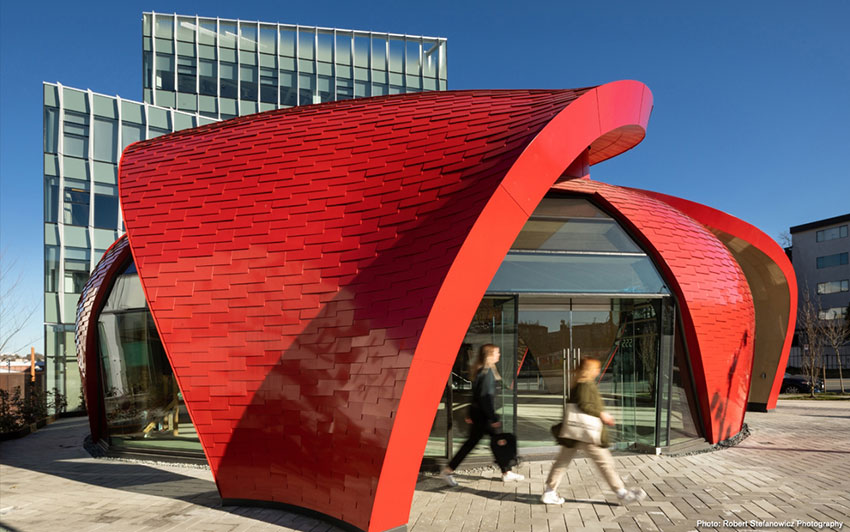
Photo: Robert Stefanowicz
Great Northern Way Pavilion, Vancouver, British Columbia.
The prefabricated design of metal panels has a huge advantage over other building materials during the construction stage at the jobsite, specifically in terms of reducing jobsite waste and positively impacting construction schedules. As the previous sections have shown, metal walls and roofs offer many significant benefits when used in commercial construction projects. But these attributes also must support both the architect’s and client’s vision for the aesthetics of a building design, and metal panels and roofs do exactly that. There’s a reason why so many innovative, award-winning buildings feature metal panels and roofs; the products lend themselves to spectacular designs that feature vibrant colors, sleek exteriors, and unique panel shapes, all while contributing to the overall sustainability of the structure.
Reducing Jobsite Waste: Aesthetics in Metal Panels and Roofs
In addition to providing products for innovative, aesthetically interesting designs, metal roof and panel systems add another level of sustainability to construction projects. Products such as IMPs and MCMs, as well as other metal panels can be customized for the project, cut to specific lengths, and include prefabricated connections. Prefabricated products tend to generate less waste than those which require on-site fabrication, reducing landfill burden. From a sustainability perspective, reduced jobsite waste contributes to a lower carbon footprint.
Customized, Cut-to-Length Pieces
Compared to other building materials such as wood, engineered wood products, or concrete, prefabricated and cut-to-length metal panels can be easily installed as is, with little or no need to modify anything on the construction site. This alone reduces jobsite waste and limits it to product packaging. Customized pieces also save a lot of time on the jobsite, and that can save money through more controlled project scheduling, and shorter installation times.
Prefabricated Hardware
Hardware needed for panel connections is also prefabricated, so everything that construction site workers need to install the metal roof or wall system should be delivered to the site ready to use. Metal roofing distributors are increasingly incorporating storefronts so supplemental materials can be acquired locally. This in turn makes installation relatively quick and easy, and it minimizes human error, and possible injury, on the jobsite.
An added benefit to having prefabricated panels and connections ready to go at the jobsite is that, compared to projects that use other materials, there tends to be more predictable scheduling. Metal panel systems aren’t as susceptible to the weather, accidents, and miscuts that delay other projects.
Factory Painting: Performance and HSW
Exterior finish is an important aesthetic and performance feature of metal panel systems. Panels are treated with reflective coatings or vibrantly colored paints that stand out as a trademark look.
Boosting the sustainability of metal panels is the way paints and finishes are applied in a factory instead of outdoors. This avoids onsite painting, reduces health and safety issues, captures and treats emissions and particulate matter inside a manufacturing facility, and increases paint performance.
Building Operation Costs: Energy-Efficiency Savings
Metal wall and roof systems contribute significantly to a building’s performance and limit operational costs. Metal roofs are highly energy efficient, thanks to their reflective properties at IR wavelengths. While other materials, such as shingles, are susceptible to UV degradation, metal is virtually unimpacted, reflecting them at lower wavelengths. When combined with insulation embedded in the metal panel or between the metal and the building, metal roofs can keep a building cooler in the summer and warmer in the winter. This translates into significant savings in heating and cooling costs. Residential properties can save 10-25 percent of energy costs. Commercial properties with large-span roofs save less percentage-wise, but gross savings can be in the thousands of dollars per year because of their size.
SPECIFYING CRADLE TO CRADLE METAL CONSTRUCTION
This section takes a broad look at the overall sustainability of metal as a reusable building material in its life cycle within the Cradle to Cradle framework.
The concept of Cradle to Cradle (C2C) design was first introduced in the 1970s by Swiss architect Walter R. Stahel as a new approach to sustainability. The term gained popularity in the early 2000s after authors William McDonough and Michael Braungart argued in their book Cradle to Cradle: Remaking the Way We Make Things that product design needed to be rethought. This reexamining shifts from a more traditional “cradle-to-grave” approach where design employs a product from material extraction and production to its use, then the landfill. C2C design, on the other hand, takes a circular approach so at the end of functional life, materials are reused in perhaps another capacity.

Author: Zhiying Lim; Creative Commons Attribution-Share Alike 3.0 Unported license.
Biological and Technical Nutrients in the Cradle to Cradle Design Framework
The C2C approach mimics the biological life cycle, where living organisms live, grow, die, and are then incorporated back into the natural system as nutrients for new plants and animals. With technological products, the design process aims for an analogous circular framework in which materials are created (ideally from recycled materials), used, cleaned, and recycled into new products. In short, the framework aims to minimize the extraction of new materials from the earth while minimizing what goes into the landfill.
This can be an intricate process for metal as most panels such as IMPs are fused with insulative materials, and most exterior panels are coated with paints and finishes to improve durability and sustainability. The same features that make metal walls and roofs ideal for long-lasting commercial and residential construction can create challenges at the end of life.
In the end, treatments and finishes, as well as insulation, all need to be factored into a product’s life-cycle analysis (LCA). Products like painted steel panels and IMPs that integrate well into a building’s operational strategy provide benefits beyond their CO2e footprint, when the designer fully utilizes them. A common error is that designers only compare Environmental Product Declarations (EPDs) of potential building materials rather than doing a life-cycle analysis for the whole building, including the use phase. Without a whole building LCA, the full benefits of the product will not be fully recognized. More importantly, simply comparing EPDs only yields an incorrect answer and assumption.
There’s a lot to consider when it comes to operational strategy, and much of it is beyond the scope of this article. That said, it’s important to understand there are critical differences between operational, biogenic embodied, and non-biogenic embodied carbon. Where operational carbon is quite straightforward (emissions of carbon dioxide and other global warming gases during the in-use operation of a building), embodied carbon is much more complicated.
Embodied carbon refers to the greenhouse gas emissions arising from the manufacturing, transportation, installation, maintenance, and disposal of building materials.
It may also include carbon dioxide equivalent (CO2e) which is part of the end-of-life cycle projected forward in time, but that is not always true. Embodied carbon is split into two categories: Biogenic and non-biogenic. Biogenic carbon is the potential CO2e from carbon physically present (e.g., sequestered) in the material itself. Non-biogenic carbon is simply embodied carbon minus biogenic carbon. Total carbon is all CO2e impacts added together, but when blindly added together, two things happen: 1) loss of the fidelity needed to properly interpret the results, and 2) potential double counting or exclusion of downstream impacts when scopes do not match. As such, it is critically important to keep the different carbon channels separate in an analysis because wood materials often claim credit for sequestration in an EPD, even when the scope of the EPD specifically excludes end-of-life. This leads to negative total carbon, which is not realistic.
Cradle to Cradle Considerations
When it comes to specifying Cradle to Cradle metal products, there are many things to consider, but at its core, the product must have gone through a rigorous review and be rated, audited, and certified to be sustainable. Approved products have been verified safe and healthy as specifically designed to be beneficial to the environment, as opposed to causing harm. In addition to being safe, healthy, and good for the environment, C2C products also do not produce volatile organic compounds (VOCs) and leave net-zero waste.
Certified products are reviewed in the following areas:
- Material Health
- Material Reutilization
- Renewable Energy
- Water Stewardship
- Social Fairness
Approved products are then awarded a Cradle to Cradle certification level as basic, bronze, silver, gold, or platinum and listed on the Cradle to Cradle Products Innovation website, and they are reviewed every two years. Some go through a third-party audit, as well, further verifying the sustainable nature of the product.
CONCLUSION AND REVIEW
Metal has long been a popular material for commercial construction projects, and modern metal wall and roof products continue to offer enhanced durability and thermal performance, increasing design options and improved energy efficiency in buildings. Metal roof and wall panels in construction can ensure a long life by protecting a structure from UV rays and keeping moisture out. Thermally insulated metal panels protect building occupants and contents, allowing for a cost-effective exterior that is relatively quick and easy to install.
These components contribute to the advantages by lessening the carbon footprint of projects constructed with metal. Metal is a sustainable material, and the manufacturing process for metal wall and roof panels is designed to minimize jobsite waste, reduce product shipping costs, and capture particulate matter from the coating and finishing process.
All the benefits extend beyond utilitarian elements. Metal allows for highly versatile designs, bright colors, and elegant natural finishes. Architects and designers can custom-design metal panels to create innovative results that are both inspiring and practical.
Rebecca Pinkus is a science and technical communication consultant focusing on technology, environment, and history. She contributes to continuing education courses and publications through Confluence Communications. www.confluencec.com












